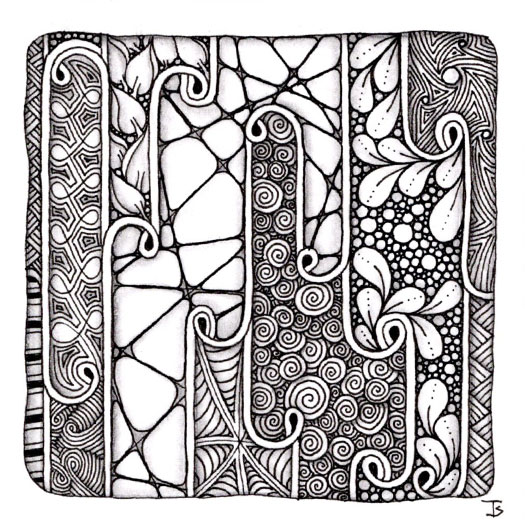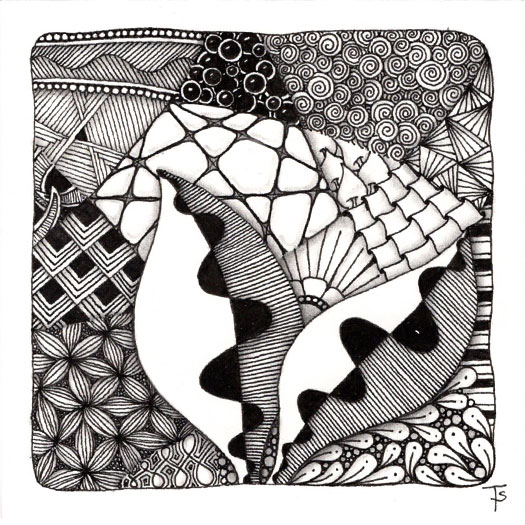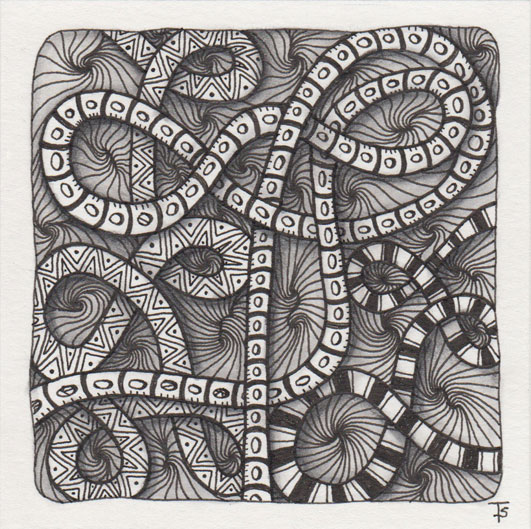If you follow me, then you know I’ve done this tangle, which can look like a sprig of Rosemary, or a pine bough, or a feather, many times before. I enjoy drawing it and it’s one of my favorites.
ATC #7.
Zentangle drawn on sahara, Fabriano Tiziano using a black and tan, Micron pen and gold gel pen. Shading done with graphite pencil.
Tangles: Marasu Tipple Verdigogh
Pink and grey is one of my favorite color combinations. So I thought I would give it a try on one of the new, grey tiles from Zentangle.
Here is a quick study on a Bijou tile, using Molygon, wrapped around a central orb and filled with Marasu.
I think it’s interesting enough that I may repeat something similar on a standard-sized tile.
Zentangle drawn on an Official, grey, Zentangle Bijou tile using a pink, grey and dark grey, Uniball Signo pens. Shading done with graphite pencil. Highlights created with white colored pencil.
Melting Mooka, introduced to us by Zentangle's Project Pack #6 , is a wonderful version of Mooka that can be used to as a string to divide a tile into smaller spaces.
These internal sections, when filled with other tangles, result in a tile that gives the impression of stained glass windows.
This was a fun, playful exercise!
Zentangle drawn on Strathmore Vellum Bristol using a black, Micron pen. Shading done with graphite pencil.
I love tangling on tan! It opens the door to so many different and interesting possiblities. And I never know how it will actually turn out.
This was inspired by another Zentangle that I did last year. But I wanted to change it up some, and recreate it on a triangular tile.
Although it didn’t show up well on the scan, I used gold ink on top of the black band on the border to create a Marasu pattern. And I used a brown pen to draw the Tipple bubbles around the central Verdigogh fronds.
Generally, now days, I use fewer tangles on a tile that I did when I began 10 years ago. But not always.
Yesterday, I decided to create a complex string and use a lot of different tangles. I had been looking through tiles from years ago and I wanted to see if I could still tangle in that style.
It took longer to choose the tangles than it did to draw them! 17 tangles is a LOT!
This tile was created following the instructions from Eni Oken ’s Art Club ’s latest lesson, Glazed Whitework .
It all started with a watercolor tile. It was an interesting challenge to draw the string and all of the tangles using a white colored pencil. Then more color was added creating the depth and shading you see here.
One of the most challenging things was to select appropriate tangles. It’s much more difficult to create detail with colored pencils than if you were using an inking pen.
String theory.
She knew that diving into the black hole to escape the pirates would be risky. But she really didn’t know how wild the ride would be. The view screen showed her the strings of realities she could follow. Which one should she choose?
Zentangle drawn on Strathmore Vellum Bristol using a black, Micron pen. Shading done with Copic marker, colored and graphite pencil.
Tangles: Coral Marasu Scute Scena
A really fun way to explore balance while maintaining interest is by using big, bold tangles! Here, Amanda has turned Springkle into a “blossom” or central motif by starting all the stems at the same point. The big, bold Marasu with the wonderfully irregular edges holds it’s own without being overwhelmed by the Springkle, however. What a wonderful balance vs tension between the two!
Zentangle drawn on Strathmore Vellum Bristol using a black, Micron pen. Shading done with graphite pencil.
This duotangle, done on a larger, apprentice-sized tile is from the 12 Days of Zentangle, Project Pack 2. For this tile, Martha instructs us in the video to draw a larger version of Paradox, which we are using as a reticula, and then filling it with Marasu fragments.
I found this very easy and relaxing to do, and I really enjoyed adding the shading and highlights. I think I’m starting to have fun doing black tiles!
For my final Crazy Huggins sampler, I cut a large, apprentice-sized tile from a new paper I got recently. I filled the tile with Crazy Huggins shapes, then filled each element with another tangle. Somewhere along the line, the design developed a mind of its own, and decided not to be symmetrical anymore. But, honestly, I think that just made it “interesting!”
This tile took quite a while to complete. I knew it might take a bit longer, but it turned out to be a lot longer! And, when I finished filling in all the shapes, I wasn’t sure I liked it. But, in true, Zentangle fashion, I continued on and shaded the design. However, it wasn’t until I added the highlights that I decided everything was fine.
Sea Waves.
She watched the waves carefully, trying to see how the odd liquid could look so solid yet still propel the Shell Ship through the coral forest. The sea had such an odd texture she wasn’t even sure it WAS a liquid at all!
Zentangle drawn on Strathmore Vellum Bristol using a black, Micron pen. Shading done with graphite pencil.
Tangles: Coral Five Oh Marasu Sea Wave Static
Yo ho ho…
Not all treasure is jewels and gold! Sometimes, the treasure lies within each of us, waiting to be discovered. If you are tangling, and looking for your own, internal treasures, follow the link over to Eni Oken's Tan Treasure Video lesson! Her video will take you through all the steps to create your personal treasure map.
Zentangle drawn on an Official Tan Renaissance tile using a black, brown and sepia Micron pens. Shading done with Copic markers, colored pencils and graphite pencil. Highlights were done with pastel pencil and gel ink. Distress ink was used for the background and edges.
Fishing.
We cast our net into the sea, searching for Ix to sell in the market. As we hauled the nets abord, we discovered a treasure trapped within. The Marasu was worth more than everything else in our nets, combined! This one, being so large, was probably worth even more than our ship! All of the fisher folk would share in this bounty when we reached the shore.
Zentangle drawn on Strathmore Vellum Bristol using a black, Micron pen. Shading done with graphite pencil.
Blossoms.
Some tangle patterns are a self-contained motif when completed. Many people call these blossom tangles. Here, I’ve used three different ones in a composition. I just wanted it to be simple, because I’m having a very busy day and don’t really have a lot of time for drawing.
Zentangle drawn on pearl grey Stonehenge multi-use paper using grey and pink Staedler pens and grey Copic multiliner. Shading done with Copic marker and colored pencil.
Dingbatz.
I‘m still trying to wrap my brain around the Dingbatz-style Mookas. I decided to try making them over-sized to see if that made any difference. I kind of like the way tese wrap around to the back of the tile. But After I did them, I realized I should apply the same techniques used for twisted ropes to them. I‘ll have to give that a try here in the future!
Larimar.
Larimar is often goes by several names… the Stone of Atlantis, Stefilia‘s Stone, and Dolphin Stone. This rare, blue variety of pectolite is found only in the Dominican Republic, in the Caribbean.
The color varies from white, light-blue, green-blue all the way through deep blue, reflecting all the different colors of the ocean.
Like other blue stones, this one is associated with the throat chakra. It facilitates the healing of the mental, and emotional healing of the individual and gives peace and comfort. This healing allows the person to speek calmly and completely about serious matters.
Tidal pool.
I went to a huge aquarium over the weekend. It was so much fun to look at all the animals that came from the sea. From tiny snails all the way up to huge sea lions, they were each so interesting in their own way!
Zentangle drawn on Strathmore Bristol Vellum using a black Micron pen.
Tangles: Cockles 'N‘ Mussels Marasu Narwal
Pockets.
This tangle reminds me of a pocket with a spiral lolipop in it. I wanted to experiment with the various brown pens in my collection, to see how much contrast there was between the various tones.
Zentangle drawn on Strathmore Bristol Vellum using a brown Micron and brown and sepia Copic pens. Shading done with Polychromos colored pencils blended with Copic blending marker.
Tangles: Buttercup Cootie Flukes Fracas Marasu Nipa Puf Quipple Rain Xircus
Movement.
I love the way the string used in this tangle conveys movement while the Marasu anchors the viewer. It‘s as if the other patterns in the tile are flowing around the spiral design.
Zentangle drawn on Strathmore Bristol Vellum using a black Micron pen.
Tangles: Botto Courant Marasu Mi2 Mixed Signals Munchin Socc Wildwood
Echoes.
I think the multiple echoes that tie up this tile are the tangle and the circular repetitions. The shapes of the Marasu and the Cogwheel echo each other. Putting the Fescu on either side of the center creates balance. Finally having the top and bottom Pinwheels echo provide a nice contrast to the more organic designs.
Zentangle drawn on Official Zentangle tile using a black, Micron pen.
Tangles: Cogwheel Fescu Linked Marasu Msst Pinwheels Verdigogh Worms Chartz Static



















